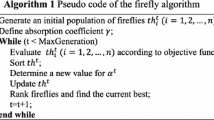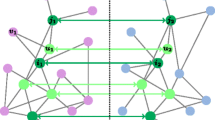Abstract
Global pairwise biological network alignment is a pervasive technique in bioinformatics and computational biology. Even now, the computation of network alignment is a challenging effort for delivering an efficient and statistically significant results. Thus, the optimization algorithms have been used to get the precise results of protein network alignment. In this work, an Improved Firefly Optimization Algorithm method was used to align the biological protein networks in a pairwise technique which resulted in an optimal solution. By utilizing the final outcome of network alignment, the function of proteins in a network and KEGG pathways was also obtained and found that the aligned proteins have more functions that are common in nature.












Similar content being viewed by others
Abbreviations
- PPI:
-
Protein–protein interaction
- GRAAL:
-
GRAph Aligner
- S3 :
-
Symmetric substructure score
- IFOA:
-
Improved Firefly Optimization Algorithm
- GoP:
-
Gene-ontology precision
- SANA:
-
Simulated annealing network aligner
References
Huang, J., Gong, M., & Ma, L. (2016). A global network alignment method using discrete particle swarm optimization. IEEE/ACM Transactions on Computational Biology and Bioinformatics, 99, 1. https://doi.org/10.1109/TCBB.2016.2618380
Ciriello, G., Mina, M., Guzzi, P. H., Cannataro, M., & Guerra, C. (2012). AlignNemo: A local network alignment method to integrate homology and topology. PLoS ONE, 7(6), e38107. https://doi.org/10.1371/journal.pone.0038107
Mina, M., & Guzzi, P. H. (2014). Improving the robustness of local network alignment: Design and extensive assessment of a Markov Clustering-based approach. IEEE/ACM Transactions on Computational Biology and Bioinformatics., 11, 561–572. https://doi.org/10.1109/TCBB.2014.2318707
Ngoc, H. T., & Xuan, H. H. (2016). ACOGNA: An efficient method for protein-protein interaction network alignment. In: Proceedings of IEEE eighth international conference on knowledge and systems engineering. https://doi.org/10.1109/KSE.2016.7758021
Elmsallati, A., Clark, C., & Kalita, J. (2015). Global alignment of protein-protein interaction networks: A survey. IEEE/ACM Transactions on Computational Biology and Bioinformatics (TCBB), 13, 689–705. https://doi.org/10.1109/TCBB.2015.2474391
Yerneni, S., Khan, I., Wei, Q., & Kihara, D. (2018). IAS: Interaction specific GO term associations for predicting protein-protein interaction networks. IEEE/ACM Transactions on Computational Biology and Bioinformatics. https://doi.org/10.1109/TCBB.2015.2476809
Wei, Q., Khan, I. K., Ding, Z., Yerneni, S., & Kihara, D. (2017). NaviGO: An interactive tool for visualization and functional similarity and coherence analysis with gene ontology. BMC Bioinformatics, 18, 177. https://doi.org/10.1186/s12859-017-1600-5
Clark, C., & Kalita, J. (2015). A multiobjective memetic algorithm for PPI network alignment. Bioinformatics, 31(12), 1988–1998. https://doi.org/10.1093/bioinformatics/btv063
Singh, R., Xu, J., & Berger, B. (2008). Global alignment of multiple protein interaction networks with application to functional orthology detection. Proceeding of the National Academy of Sciences of the United States of America., 105, 12763–12768. https://doi.org/10.1073/pnas.0806627105
Memisevica, V., & Przulj, N. (2012). C-GRAAL: Common-neighbors-based global GRAph ALignment of biological networks. Integrated Biology., 7, 734–743. https://doi.org/10.1039/c2ib00140c
Malod-Dognin, N., & Przulj, N. (2015). L-GRAAL: Lagrangian graphlet-based network aligner. Bioinformatics, 31, 2182–2189. https://doi.org/10.1093/bioinformatics/btv130
Kuchaiev, O., & Przulj, N. (2011). Integrative network alignment reveals large regions of global network similarity in yeast and human. Bioinformatics, 27, 1390–1396. https://doi.org/10.1093/bioinformatics/btr127
Patro, R., & Kingsford, C. (2012). Global network alignment using multiscale spectral signatures. Bioinformatics, 28, 3105–3114. https://doi.org/10.1093/bioinformatics/bts592
Hashemifar, S., Ma, J., Naveed, H., Canzar, S., & Xu, J. (2016). ModuleAlign: Module-based global alignment of protein-protein interaction networks. Bioinformatics, 32, i658–i664. https://doi.org/10.1093/bioinformatics/btw447
Kazemi, E., Hassani, H., Grossglauser, M., & Modarres, H. P. (2016). PROPER: Global protein interaction network alignment through percolation matching. BMC Bioinformatics, 17, 527. https://doi.org/10.1186/s12859-016-1395-9
Dognin, N. M., Ban, K., & Pruzlj, N. (2017). Unified alignment of protein-protein interaction networks. Scientific Reports., 7, 953. https://doi.org/10.1038/s41598-017-01085-9
Saraph, V., & Milenkovic, T. (2014). MAGNA: Maximizing accuracy in global network alignment. Bioinformatics, 30, 2931–2940. https://doi.org/10.1093/bioinformatics/btu409
Vijayan, V., Saraph, V., & Milenkovic, T. (2015). MAGNA++: Maximizing accuracy in global network alignment via both node and edge conservation. Bioinformatics, 31, 2409–2411. https://doi.org/10.1093/bioinformatics/btv161
Ibragimov, R., Martens, J., Guo, J., & Baumbach, J. (2013). NABEECO: Biological network alignment with bee colony optimization algorithm. In: Proceeding of 15th annual conference companion on genetic and evolutionary computation (pp. 43–44). https://doi.org/10.1145/2464576.2464600
Tuncay, E. G., & Can, T. (2016). SUMONA: A supervised method for optimizing network alignment. Computational Biology and Chemistry., 63, 41–61. https://doi.org/10.1016/j.compbiolchem.2016.03.003
Chindelevitch, L., Ma, C. Y., Liao, C. S., & Berger, B. (2013). Optimizing a global alignment of protein interaction networks. Bioinformatics, 29, 2765–2773. https://doi.org/10.1093/bioinformatics/btt486
Mamano, N., & Hayes, W. B. (2017). SANA: Simulated Annealing far outperforms many other search algorithms for biological network alignment. Bioinformatics, 33, 2156–2164. https://doi.org/10.1093/bioinformatics/btx090
Sun, Y., Crawford, J., Tang, J., & Milenkovic, T. (2014). Simultaneous optimization of both node and edge conservation in network alignment via WAVE. In M. Pop, sH. Touzet (Eds.), Algorithms in bioinformatics. WABI 2015. LNCS (p. 9289). https://doi.org/10.1007/978-3-662-48221-6_2.
Yang, X. (2009). Firefly algorithms for multimodal optimization. stochastic algorithms: Foundations and applications SAGA 2009. LNCS (p. 5792). Heidelberg: Springer. https://doi.org/10.1007/978-3-642-04944-6_14
Kaur, K., Salgotra, R., & Singh, U. (2017). An improved firefly algorithm for numerical optimization. Proceedings of International Conference on Innovations in Information, Embedded and Communication Systems. https://doi.org/10.1109/ICIIECS.2017.8275914
Kuchaiev, O., Milenkovic, T., Memisevic, V., Hayes, W., & Przulj, N. (2010). Topological network alignment uncovers biological function and phylogeny. Journal of Royal Society Interface. https://doi.org/10.1098/rsif.2010.0063
Szklarczyk, D., Gable, A. L., Lyon, D., Junge, A., Wyder, S., Cepas, J. H., Simonovic, M., Doncheva, N. T., Morris, J. H., Bork, P., Jensen, L. J., & Mering, C. V. (2019). STRING v11: Protein–protein association networks with increased coverage, supporting functional discovery in genome-wide experimental datasets. Nucleic Acids Research., 47, D607–D613. https://doi.org/10.1093/nar/gky1131
Kerrien, S., Aranda, B., Breuza, L., Bridge, A., Broackes-Carter, F., Chen, C., Duesbury, M., Dumousseau, M., Feuermann, M., Hinz, U., et al. (2012). The intact molecular interaction database in 2012. Nucleic Acids Research, 40, D841–D846. https://doi.org/10.1093/nar/gkr1088
Chatr-aryamontri, A., Breitkreutz, B.-J., Heinicke, S., Boucher, L., Winter, A., Stark, C., Nixon, J., Ramage, L., Kolas, N., O’Donnell, L., et al. (2013). The biogrid interaction database: 2013 update. Nucleic Acids Research., 41, D816–D823. https://doi.org/10.1093/nar/gks1158
Needleman, S. B., & Wunsch, C. D. (1970). A general method applicable to the search for similarities in the amino acid sequence of two proteins. Journal of Molecular Biology., 48, 443–453. https://doi.org/10.1016/0022-2836(70)90057-4
Author information
Authors and Affiliations
Corresponding author
Ethics declarations
Conflict of interest
There are no conflicts of interest.
Competing interests
The authors declare no competing financial interests.
Additional information
Publisher's Note
Springer Nature remains neutral with regard to jurisdictional claims in published maps and institutional affiliations.
Supplementary Information
Below is the link to the electronic supplementary material.
Rights and permissions
About this article
Cite this article
Ranjani Rani, R., Ramyachitra, D. Improved Firefly Optimization for Pairwise Network Alignment with its Biological Significance of Predicting GO Functions and KEGG Pathways. Wireless Pers Commun 121, 2823–2844 (2021). https://doi.org/10.1007/s11277-021-08851-z
Accepted:
Published:
Issue Date:
DOI: https://doi.org/10.1007/s11277-021-08851-z




